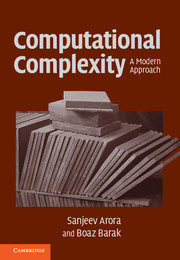Book contents
- Frontmatter
- Contents
- About this book
- Acknowledgments
- Introduction
- 0 Notational conventions
- PART ONE BASIC COMPLEXITY CLASSES
- PART TWO LOWER BOUNDS FOR CONCRETE COMPUTATIONAL MODELS
- PART THREE ADVANCED TOPICS
- 17 Complexity of counting
- 18 Average case complexity: Levin's theory
- 19 Hardness amplification and error-correcting codes
- 20 Derandomization
- 21 Pseudorandom constructions: Expanders and extractors
- 22 Proofs of PCP theorems and the Fourier transform technique
- 23 Why are circuit lower bounds so difficult?
- Appendix: Mathematical background
- Hints and selected exercises
- Main theorems and definitions
- Bibliography
- Index
- Complexity class index
23 - Why are circuit lower bounds so difficult?
from PART THREE - ADVANCED TOPICS
Published online by Cambridge University Press: 05 June 2012
- Frontmatter
- Contents
- About this book
- Acknowledgments
- Introduction
- 0 Notational conventions
- PART ONE BASIC COMPLEXITY CLASSES
- PART TWO LOWER BOUNDS FOR CONCRETE COMPUTATIONAL MODELS
- PART THREE ADVANCED TOPICS
- 17 Complexity of counting
- 18 Average case complexity: Levin's theory
- 19 Hardness amplification and error-correcting codes
- 20 Derandomization
- 21 Pseudorandom constructions: Expanders and extractors
- 22 Proofs of PCP theorems and the Fourier transform technique
- 23 Why are circuit lower bounds so difficult?
- Appendix: Mathematical background
- Hints and selected exercises
- Main theorems and definitions
- Bibliography
- Index
- Complexity class index
Summary
The main hurdle in proving a lower bound is the existence of an algorithm.
–Steven RudichWhy have we not been able to prove strong lower bounds for general circuits? Despite the dramatic success in proving lower bounds on restricted circuit classes as described in Chapter 14, we seem utterly at a loss when it comes to showing limitations of general Boolean circuits.
In 1994 Razborov and Rudich [RR94] described what they view as the main technical limitation of current approaches for proving circuit lower bounds. They defined a notion of “natural mathematical proofs” for a circuit lower bound. They pointed out that current lower bound arguments involve such mathematical proofs, and showed that obtaining strong lower bound with such proof techniques would violate a stronger form of the P ≠ NP conjecture–specifically, the conjecture that strong one-way functions exist that cannot be inverted by algorithms running in subexponential time. Since current evidence suggests that such strong one-way functions do exist (factoring integers, discrete log, etc., as described in Chapter 9), we conclude that current techniques are inherently incapable of proving strong lower bounds on general circuits.
The Razborov-Rudich result may be viewed as a modern analog of the 1970s results on the limits of diagonalization (see Chapter 3). What is particularly striking is that computational complexity (namely, the existence of strong one-way functions) is used here to shed light on a metamathematical question about computational complexity: “Why have we been unable to prove P ≠ NP?”
Information
- Type
- Chapter
- Information
- Computational ComplexityA Modern Approach, pp. 498 - 507Publisher: Cambridge University PressPrint publication year: 2009
